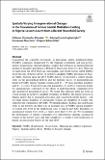Spatially varying intergenerational changes in the prevalence of female genital mutilation/cutting in Nigeria : lessons learnt from a recent household survey
Abstract
Considering the concerted investments in anti-female genital mutilation/cutting (FGM/C) campaigns championed by the Nigerian government and non-governmental organizations, research findings suggest that reduction in intergenerational (mother-to-daughter) prevalence of FGM/C in Nigeria has been very slow. What can we learn from the 2018 Nigerian Demographic and Health Survey (2018 NDHS) about the roles of the key drivers of mother-to-daughter FGM/C prevalence in Nigeria? Here, drawing upon the 2018 NDHS dataset, we provided a context-specific study on the geographical patterns and the enabling factors of intergenerational trends in FGM/C among Nigerian women aged 15 – 49 years and their daughters aged 0 – 14 years. Using Bayesian semi-parametric geo-additive regression model, we simultaneously controlled for the effects of individual-level, community-level and unobserved geographical factors. We learnt that although there has been an overall decline in mother-to-daughter prevalence of FGM/C, the practice persists in Nigeria largely due to geographical location and social norm related factors – risk was high among daughters of circumcised women and daughters of women who supported the continuation of FGM/C. We identified Kano, Kaduna, Imo and Bauchi states as the hotspots and there was an increased risk of FGM/C among daughters of women who lived in the neigbouring states of Jigawa and Yobe. Daughters of circumcised women were about 2.7 times more likely to be cut. We recommend the development of tailored community-level interventions targeting circumcised women in the hotspot states and their neighbours to ensure a total eradication of female circumcision in Nigeria by the year 2030.
Citation
Nnanatu , C C , Fagbamigbe , A F , Afuecheta , E & Utazi , C E 2023 , ' Spatially varying intergenerational changes in the prevalence of female genital mutilation/cutting in Nigeria : lessons learnt from a recent household survey ' , Applied Spatial Analysis and Policy , vol. 16 , no. 2 , pp. 703-727 . https://doi.org/10.1007/s12061-022-09497-5
Publication
Applied Spatial Analysis and Policy
Status
Peer reviewed
ISSN
1874-4621Type
Journal article
Collections
Items in the St Andrews Research Repository are protected by copyright, with all rights reserved, unless otherwise indicated.

